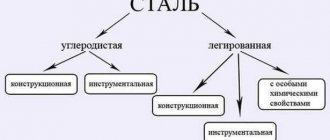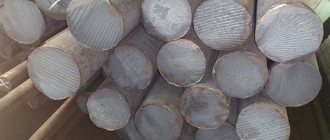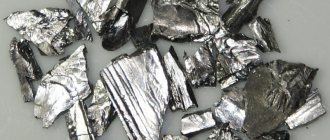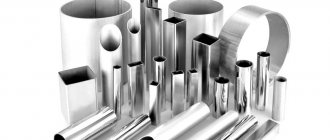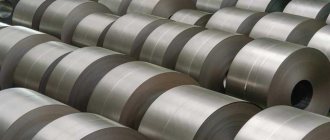Magnetic and non-magnetic steels and alloys
Magnetic and non-magnetic steels and alloys
- Magnetic and non-magnetic steel and alloy Magnetic steels and alloys The main parameters of magnetic materials are the residual magnetic induction Br, coercivity Hc, permeability P. Vg (gpl) characterizes the magnetization of the magnetic field and the magnetic induction that remains in the sample after its termination. Hs (a/m) is the magnetic field strength required to demagnetize it, applied to the sample. The dependence of magnetic induction B on magnetic field H is shown in the figure. 15.13.
Permeability depends on the ratio P =〜(GN / m). Depending on their magnetic properties, magnetic materials are divided into diamagnetic, paramagnetic and ferromagnetic. In diamagnetic materials, including Cu, Ag, Zn, Hg, etc., P 1. Ferromagnetic materials: Fe, Ni, Co and their alloys, Cr and Mn and other alloys are characterized by high magnetic permeability. Magnetization of tens and hundreds of ferromagnetic materials Thousands of times the original magnetic strength of the filament field.
Magnetic steel and alloy according to the value of HK and I. They are divided into hard magnetic (used for permanent magnets) and soft (used for variable magnetization). Lyudmila Firmal
For cores, transformers, electric motors, generators, low-current parts). Alloying can increase the magnetic hardness (increase in Hs). If only a solid solution is formed in a ferromagnet, then the magnetic hardness (and it) increases slightly. However, when the 2nd phase (exceeding the solubility limit) is formed, the magnetic hardness (and Hc) increases significantly. In in this case, the magnetic hardness of the alloy (and 15.13 the dependence of magnetic induction on magnetic field: 1-hysteresis curve. Primary ns curve.)
A change in the structure (crystal lattice stress due to hardening or phase transformation, grain refinement, etc.), an increase in the hardness of the alloy, an increase in the magnetic hardness (and Hc) at the same time. Magnetic hard steels and alloys are characterized by wide hysteresis loops, large Br and He, and small p. The optimal structure of hard magnetic steel is martensite (containing small particles of cementite or carbide), which is obtained after hardening or aging. Hard magnetic materials are used in the manufacture of permanent magnets for electrical and radio equipment (magnets, various measuring instruments, relays, magnetic storage devices, storage devices, computing devices, electronic computers).
- The higher the B value, the higher the magnetic energy of the sample, and the higher the Hc . Permanent magnets are made of high-carbon, alloy steel, a special alloy. As shown, carbon steel after quenching acquires sufficient magnetic properties (U10-U12 steel). This is due to the fact that the Hc value increases significantly after quenching with martensite as a result of stresses in the crystal lattice. However, due to its low hardenability, aging tendency, and loss of magnetic properties, alloy steel is more effective as a magnetically difficult material than carbon steel.
Steels containing Cr, W and Co are easily hardened. The magnetic properties of chromium and carbon steel are almost identical. Tungsten steel and cobalt steel have superior stability and greatly improved magnetic properties. 15.12, mainly the characteristic after heat treatment of the tong. 15.13. Table 15 12 Chemical composition of magnetic steel (GOST 802-58) Chemical composition of March steel、% Approx. V. MO. EX. 0.95-1.10 1.3-1.6 00. 90-1. 10 2.8-3.6 E7B6. 0.68-0.78 0.3- 0.5 5.2-6.2 W EX5K5 0.90-1.05 5.5-6.5 5.6-6.5 co., Limited EX9K15M 0.90-1.05 8.0-10.0 /13.5-16.5 co | 1.2-1.7 MO Table 15.13
The chemical composition of electromagnetic steel is given in the table. Lyudmila Firmal
Basic properties of magnetic steel after heat treatment (GOST 802-58) Processing mode Markl steel, °C in gg » f / f Air curing (normalization)|. «vakalkya 2nd holiday for the treatment of colds EX 1000 830-850 0.90 4 640 ЕХЗ1050840-860 0.95 4800 E7B6 1200-1250 820-860 I AL-1.00 4 960 EX5Ke 1150-1200 930-950 - / and IM) 0.85 8 000 EX9KI5M 1200-1230 1030-105 0 0.80 13 600 Special magnetic alloys - low carbon Fe alloys -Ni-Al and Cu (or Cu and Co) additives have very high magnetic properties, so high-power magnets can be made from them (Fig. 15.14). The magnetic properties of these alloys are enhanced by aging after hardening.
Magnetic alloys are very hard, brittle and cannot be machined. These alloy magnets are made by casting or sintering from powder. Figure 15.14 hysteresis curve of a hard alloy Co forms a continuous solid solution with Ni, which enhances the magnetic properties of alloys containing high He content (see Figure 15.14). The chemical composition, basic properties and purpose of the hard magnetic alloy are given in the table. 15.14.
Table 15.14 Chemical composition, basic properties and purpose of hard magnetic alloys based on Fe-Ni-Al and Fe-N1-Co-Al (GOST 10160-62) Rank chemical composition splaia.% (Si-0.15) “gt” GA / M purpose Ni Al-Co(Ci) AN1 22 11 0.70 per 20,000 constant An2 24.5 13 3.5 Cu 0.60 34 400 nits normal magnetic Change 23.5 15.5 4.0 KR 0.50 40,000 nits energy(0.875-1.25 J / L - » - 10 - ' ) ANC 33 13.5-0.40 36 000 AHKol * 18 10 12.0 C 6.0 C 0.68 40 000 the same, increasing magnetic energy ANKO2 20 9 15.0 Co 4.0 C 0.75 48 000 J (1.75-1.875 j / l' - KN) ANKOZ 19 10 18.0 Co 3.0 Cu 0.90 52,000 1 the same for high magnetic energy ANKO4 13.5 9 24.0 3.0 together with 1.23 40,000(> 1.875 J / x - s- “) Table 15.15.
Chemical composition, basic properties and purpose of precision hard magnetic alloys (GOST 10994-64) Silane grade chemical composition,% B, - t. » C / Chey's treasury Use si Mp st NIKO in 52KF111 52KF13/ α - are reduced by metamorphosis to normal temperature. Non-magnetic steel is used in the manufacture of installations intended for high mechanical loads.Non-magnetic steel contains 18.5-21.5% Ni in EI269, and 55G9N9KhZ steel contains 7.5-9.5% Ni and 7.5-9.5% MP.
Claim
Cold-resistant, low-magnetic steel for components and parts of drilling equipment, containing carbon, manganese, chromium, aluminum, boron, cerium, calcium and iron, characterized in that it additionally contains vanadium, niobium and yttrium, wt.%:
| Carbon | 1,0-1,2 |
| Manganese | 24,0-26,0 |
| Chromium | 2,5-5,0 |
| Aluminum | 4,0-6,0 |
| Bor | 0,005-0,1 |
| Yttrium | 0,005-0,05 |
| Cerium | 0,005-0,05 |
| Vanadium | 0,08-0,12 |
| Niobium | 0,01-0,04 |
| Calcium | 0,001-0,01 |
| Iron | Rest |
What determine the magnetic properties of materials?
To determine the magnetic properties of stainless steel and other alloys, a certain formula is used, which reflects the proportionality coefficient and magnetic susceptibility. Depending on the type of factor used, stainless steel falls into one of several groups:
- When the coefficient is above zero, the material belongs to the group of paramagnets.
- When using zero, stainless steel is diamagnetic.
- Ferromagnets are characterized by good magnetic susceptibility. This group includes nickel, cadmium and iron.
Magnetic properties of stainless steel
Stainless steel becomes magnetic when exposed to a certain field. Such a reaction is associated with the structural features of the alloy, and to some extent, with the chemical composition. Some substances are characterized by reacting to the influence of a magnet.
Welding technology
Before carrying out work, it is necessary to warm up the parts to 150-200 degrees Celsius. After this, welding work is performed. Then the finished product should cool slowly. This method reduces the likelihood of cracks forming.
Welding work is carried out using coated electrodes Esab OK 68.81, UONI 13/55, Lb-52U, using semi-automatic welding in carbon dioxide with ESAB OK Autrod 312 and ESAB OK Autrod 16.95 wire or in an argon environment.
Upon completion of work, it is recommended to place the part in the oven and heat it at a temperature of 400-450 degrees Celsius (normalization process) for about 1 hour.
After the product has completely cooled, it is necessary to perform tests depending on the purpose of the structure: tensile, torsion, impact loads or bending. If critical metal structures are being created, then for verification it is recommended to contact specialized organizations that conduct tests of finished connections.
Manual arc welding is carried out in accordance with GOST 5264-80, which indicates the types of connections used and structural elements with information on their dimensions.
How to determine whether magnetic or non-magnetic steel is stainless?
As previously noted, it is possible to determine whether stainless steel is magnetic without the use of special equipment. Among the features of the procedure, we note the following points:
- The test area should be polished to a high shine. Hand tools and special materials can be used for this.
- A few drops of concentrated copper sulfate are applied to the cleaned area.
- If the metal is stainless steel, then a red coating will appear on the surface.
Determination of magnetic properties using vitriol
This process allows you to determine which stainless steel is magnetic and which is not corrosion resistant. It is almost impossible to determine the characteristics of a food alloy on your own.
Magnetic properties can also be checked using a regular magnet. However, it does not give an accurate result.
That is why it is recommended to purchase products from reputable manufacturers.
Portable metal analyzer
In conclusion, we note that magnetic properties do not in any way reduce the corrosion resistance of the surface. That is why such alloys are characterized by a wide range of applications.
Read also: What is injection molding
If you find an error, please select a piece of text and press Ctrl+Enter.
Are there magnetic stainless steels and how does this affect corrosion resistance?
There is no clear answer to the question of whether stainless steel is magnetic, since the magnetic properties of alloys are determined by the properties of their structural components.
Classification of materials according to their magnetic properties
Bodies placed in a magnetic field become magnetized. The magnetization intensity (J) is directly proportional to the increase in field strength (H):
J= ϰH, where ϰ is a proportionality coefficient called magnetic susceptibility.
If ϰ>0, then such materials are called paramagnetic, and if ϰ
Some metals - Fe, Co, Ni, Cd - have extremely high positive susceptibility (about 105); they are called ferromagnets. Ferromagnets are intensely magnetized even in weak magnetic fields.
Stainless steels for industrial use may contain ferrite, martensite, austenite, or combinations of these structures in different proportions. It is the phase components and their ratio that determine whether a stainless steel is magnetic or not.
Magnetic stainless steel: structural composition and grades
There are two phase components of steel with strong magnetic characteristics:
- Martensite, from the point of view of magnetic properties, is a pure ferromagnet.
- Ferrite can have two modifications. At temperatures below the Curie point, it, like martensite, is ferromagnetic. High temperature delta ferrite is paramagnetic.
Thus, corrosion-resistant steels, the structure of which consists of martensite, are magnetic stainless steel. These alloys react to magnets like regular carbon steel. Ferritic or ferritic-martensitic steels can have different properties depending on the ratio of phase components, but, most often, they are ferromagnetic.
This category includes chromium and some chromium-nickel steels. They are divided into the following subgroups:
- Martensitic steels are hard and can be strengthened by quenching and tempering, just like regular carbon steels. They are used mainly for the production of cutlery, cutting tools and general mechanical engineering.
Steels 20Х13, 30Х13, 40Х13 martensitic class are produced mainly in a heat-treated ground or polished state
Chromium-nickel martensitic steel 20Х17Н2 has higher corrosion resistance than 13% chromium steels. This steel is highly manufacturable - it lends itself well to stamping, hot and cold, can be processed by cutting, and can be welded by all types of welding.
- Ferritic steels of type 08Х13 are softer than martensitic steels due to their lower carbon content. One of the most consumed ferritic steels is the magnetic corrosion-resistant alloy AISI 430, which is an improved analogue of grade 08Х17. This steel is used for the manufacture of technological equipment for food production, used for washing and sorting food raw materials, grinding, separating, sorting, packaging, and transporting products.
- Ferritic-martensitic steels (12Х13) have martensite and structurally free ferrite in their structure.
Non-magnetic stainless steel
Non-magnetic alloys include chromium-nickel and chromium-manganese-nickel steels of the following groups:
- Austenitic steels occupy a leading position in terms of production volume. Non-magnetic stainless steel of the austenitic class is widely used - AISI 304 steel (analogue - 08Х18Н10). This material is used in the production of equipment for the food industry, the manufacture of containers for kvass and beer, evaporators, cutlery - pots, pans, bowls, kitchen sinks, in medicine - for needles, marine and refrigeration equipment, plumbing equipment, tanks for various liquids composition and purpose and dry substances. Steels 08Х18Н10, 08Х18Н10Т, 12Х18Н10Т (used in hardware A2), 10Х17Н13М2Т (used in hardware for use in aggressive environments, acid-resistant and salty, A4) have excellent manufacturability and high corrosion resistance even in chemical production vapors and ocean waters.
- Austenitic-ferritic steels are characterized by a high chromium content and a low nickel content. Additional alloying elements are molybdenum, copper, titanium or niobium. These steels (08Х22Н6Т, 12Х21Н5Т, 08Х21Н6М2Т) have some advantages over austenitic steels - higher strength while maintaining the required ductility, greater resistance to intergranular corrosion and corrosion cracking.
Production of electrical control and protection devices - Low-magnetic materials, conductors
Page 2 of 71
Alloys based on copper and aluminum (Table 1-2) and stainless chromium-nickel steels are used as low-magnetic materials. Chrome-nickel steels grade X18N9T also have high corrosion resistance. Bronzes are used mainly as antifriction materials with high wear resistance. The antifriction properties of bronzes are associated with the isolation of copper atoms (atomic dispersity) in alloys, while in pure copper its atoms are in a state of association (molecular dispersity). Metal-ceramic structural materials based on iron, steel, bronze and brass are used in electrical devices instead of the usual ones for the manufacture of bolts, nuts, plates, levers, rollers, pulleys, gears, anti-friction parts, etc. Metal-ceramic parts are well processed by cutting tools and easily accept anti-corrosion coatings and can be subjected to heat treatment according to normal conditions. The main technical data of metal-ceramic materials based on iron, steel and bronze are given in table. 1-3. Table 1-3
| Material | Carbon content, % | Tensile strength-107, Pa | Brinell hardness-107, Pa | Density-10, kg/m3 |
| Sintered iron | 0,1 | 30 | 40 | 7,6 |
| Sintered steel (without hardening) | 0,5 | 40 | 120 | 7,6 |
| Metal-ceramic composition bronze-graphite | 1% graphite | 35 | 70 | 7,7 |
The microstructure of cermet iron is ferrite polyhedra with uniformly distributed pore inclusions. The microstructure of steel is a mixture of ferrite and pearlite sections. The microstructure of the bronze-graphite composition is polyhedra of a copper-tin solid solution with graphite inclusions. Antifriction metal-ceramic materials include iron-graphite and bronze-graphite compositions. The use of metal-ceramic antifriction parts significantly simplifies the design of the bearing, reduces the starting torque, improves run-in, reduces wear of the rubbing pair and facilitates maintenance; 30% of the volume of the part consists of pores filled with lubricant. This ensures self-lubrication and low noise. The main technical data of antifriction cermet materials are given in table.
Conductor materials include copper, aluminum, silver, and copper-based alloys. Copper is the most widely used conductor material in the electrical industry. Copper has the highest electrical and thermal conductivity after silver. It is fully resistant to atmospheric corrosion, has high ductility, can be easily soldered and welded, and has sufficient mechanical strength. Copper is rolled into sheets, strips and drawn into wire, the thickness of which can be thousandths of a millimeter. The tensile strength of hard unannealed copper reaches 40-107 Pa, and for soft annealed copper it reaches 20·107 Pa. Alloys of copper with tin, silicon, phosphorus, beryllium, chromium, cadmium, etc. - bronze - have significantly higher mechanical properties than copper and can reach a tensile strength of 135 × 107 Pa. However, their resistivity is higher, which limits their use as conductors. Cadmium bronze has the best set of properties. At a tensile strength of 80 -107 Pa, its electrical conductivity decreases slightly compared to copper. Brasses - alloys of copper with zinc and other metals - are used for the manufacture of lead busbars in electrical devices. For the manufacture of long conductors, power coils and in units where large losses are unacceptable, copper is used. By adding other alloying elements to the copper-zinc alloy, special brasses are obtained, designated by the name of the additional element. Leaded brass LS59-1 has increased machinability, but is brittle; silicon brass has good casting properties, etc. L62 brass, used for the manufacture of short leads and busbars, has a fairly high relative elongation with a higher tensile strength compared to copper. This gives it technological advantages when processing by stamping, drawing, etc. For the manufacture of current conductors, solid copper tape with a thickness of 0.06–0.13 mm, PShch and PShchS wire with a thickness of 0.3–10 mm, and busbar copper grade Ml ( GOST 434-71), etc. Due to the limited reserves of copper ore, aluminum is currently used as a conductor material, the possibilities of extracting raw materials for the production of which are unlimited. The most widely used aluminum bus wire is grade A1 (GOST 5414-63). Aluminum is 3.5 times lighter than copper, but has lower mechanical strength and electrical conductivity. The surface of the aluminum part is covered with a thin but durable oxide film. This film protects aluminum from further corrosion and requires the use of special solder pastes for soldering.
- Back
- Forward
Stainless steels with good magnetic properties
The magnetic properties of stainless steel largely depend on the structure of the material. They manifest themselves most in the following cases:
- Martensite is characterized by good magnetic properties and is ferrimagnetic in its pure form. This kind of stainless steel is extremely rare, since it is quite difficult to maintain a pure chemical composition. Like conventional carbon versions, this one can be improved by hardening or tempering. This metal is widely used not only in industry, but also in everyday life. The most widely used brands are: 20X13 and 40X13. They can be subjected to mechanical action, grinding or polishing, as well as various heat treatments. Features of the chemical composition include an increased concentration of chromium and carbon. 20Х17Н2 is another stainless steel, which is characterized by a high concentration of chromium. Due to this, the structure becomes more resistant to moisture and some aggressive agents. Despite the large number of alloying elements, spain is weldable and can be hot or cold forged.
- Ferrite, depending on the degree of heating, can take two forms: ferromagnetic and paramagnetic. The chemical composition of such materials contains less carbon, making them softer and easier to process. This group includes stainless steel 08Х13, which is actively used in the food industry. In addition, this group includes AISI 430, which is used in food production plants.
- Martensitic-ferritic alloys are characterized by very attractive performance properties. Alloy 12X13 has a similar structure. Like previous metals, this one can be subjected to mechanical and thermochemical processing.
Steel 20Х13 Steel 40Х13
The above information indicates that the martensitic structure has the most pronounced magnetic properties.
When choosing an alloy, it should be taken into account that not all stainless steels are resistant to mechanical damage. Even minor impacts can damage the surface layer. Despite the fact that the chromium film can be restored upon contact with oxygen, new alloys have been produced that are characterized by increased mechanical stability.
Admiralty Shipyards
- Log in to reply to this topic
#21 70rufs
- Top
- Insert nickname
#22 morgmail
- Top
- Insert nickname
#23 AVN
- Top
- Insert nickname
#24 p0tap4ik
- Top
- Insert nickname
#25 AVN
- Top
- Insert nickname
#26 p0tap4ik
Unfortunately, Google, like the Websvarka forum, is not used when handing over structures in shipbuilding, because... are not governing documents and OSTs. According to the Internet version, how should steel 09khn2md be welded? Try to find EA 868/20 on the Internet, let's see what it says there.
- Top
- Insert nickname
#27 AVN
- Top
- Insert nickname
#28 morgmail
- Well done, and why didn’t you stay at DalZavod, for example as a technologist?
In your opinion, is sea water an aggressive environment?
- Top
- Insert nickname
#29 AVN
Steel cannot be used for friction parts and parts operating in aggressive environments.
- Top
- Insert nickname
#30 p0tap4ik
And what exactly of pearlitic and austenitic steels can be welded with these electrodes (868/20) How, according to the Internet version, should steel 09khn2md be welded
In your opinion, is sea water an aggressive environment?
- Top
- Insert nickname
#31 AVN
- Top
- Insert nickname
#32 psi
Western Yakutia call any time 89142527650 hash tag #ykt_master
- Top
- Insert nickname
#33 AVN
Attached images
- Top
- Insert nickname
#34 AVN
conduct some kind of introductory briefing
- Top
- Insert nickname
#35 OLEG
- Top
- Insert nickname
#36 AVN
there are chief welders, let them sort out these documents and write technologies
sometimes they sit and play cards at the computer, and in argon technology, titanium arc welding with reverse polarity
- Top
- Insert nickname
Stainless steel that is magnetic
Ferritic alloys
They contain chromium in large quantities, approximately 20%. They have high magnetic properties and resistance to corrosion. They acquire greater softness due to a decrease in carbon composition and are easily amenable to various types of processing. Most often, such alloys are used in heavy industry, at food industry enterprises, and elements of heating systems are also made from them. They are cheaper than austenitic alloys.
Some features of ferritic alloys allow them to be used to replace more expensive materials:
- low level of thermal expansion and thermal conductivity;
- increased temperature resistance and fluidity;
- resistance to deformation and corrosion.
This allows these alloys to be used in the manufacture of electromagnetic drives and actuators.
Martensitic alloys
They have increased strength and are not inferior to carbon steels, thanks to hardening and tempering. These are absolute ferromagnets. They are rare because it is difficult to maintain a pure composition. Alloys with a high chromium content are resistant to humidity and aggressive environments. Excellent weldability, both hot and cold stamping can be used.
Martensites are heat-resistant and capable of self-hardening. They are used in mechanical engineering for the production of abrasives, in the production of cutlery, elements of pumping systems, springs, surgical and various cutting instruments. Among stainless steels, martensitic alloys have the highest magnetizability.
Martensitic-ferritic alloys
They have good performance characteristics and are easy to heat treat. But when welding they tend to form cold cracks. They are used when surfaces that are often exposed to heating are required, such as collectors, boilers, and pipelines.
ETS production
Electrical steel is smelted in blast furnaces at a temperature of 1500-16500 C using the complete oxidation method, which reduces the content of oxygen and harmful impurities in the material to a minimum. Mild steel is obtained, which is cast into ingots or platinum weighing from 0.5 tons or slabs measuring 140X630 mm and 140X1000 mm.
The most popular grades of non-alloy steel: 10880, 10895, 10850, 10860, 11880, 11895, 20880, 21880, 21895 and others, where the first digit indicates the class according to the type of pressure treatment:
- Digit 1 (hot rolled and forged),
- Number 2 (calibrated) shows that the steel has undergone additional processing by cold drawing with a change in the size of the workpiece using roll compression.
The second number shows the silicon content in the workpiece:
- 0 – unalloyed with a silicon content of up to 0.03% without an established aging coefficient (changes in the properties of the metal over time),
- 1 – the aging coefficient is set, that is, the absence of changes in the properties and microstructure of the material is guaranteed.
The number 8 indicates the main qualitative indicator, for this type it is the coercive force.
The fourth and fifth digits establish a quantitative indicator of the coercive force for a given class of steel in whole units of ampere/meter.
Types, ferromagnetic properties and physical quality indicators are formed during the process of rolling blanks into thin sheets or strips.
At the stage of obtaining rolled sheets from steel blanks, two production technologies are used: hot-rolled and cold-rolled processing.
The hot-rolling method involves preheating the slabs to a temperature of 800-13000 C. Then the heated billets are fed to the rolling mill. A rolling mill is a set of alternating rolls with different gap thicknesses between them. The heated workpiece, passing alternately between them, under pressure with the help of plastic deformation, changes the thickness from 7.5 mm-60 mm to 0.05 mm-2 mm. Preheating increases the ductility of the material, but the increased temperature changes the properties of the steel.
Hot rolled electrical steels contain the maximum possible amount of silicon from 3.5% to 4.5%. It has a coarse-crystalline structure with a random arrangement of grains, which reduces its magnetic characteristics. After rolling, the physical properties are the same in all directions, so hot-rolled steel is only isotropic.
Cold-rolled electric steel is produced at ambient temperature in two stages. At the first stage, sheet metal is rolled to a thickness of more than 0.5 mm. Then the steel is cut into sheets or rolled into a roll and annealed at a temperature of 1150-11800 C, followed by rolling to the required thickness. Cold rolled steel can be isotropic or anisotropic. Anisotropic materials have physical properties that are enhanced along the movement of the rolls, which leads to strict structuring of electromagnetic fluxes along the horizontal axis of the metal grains.
Non-magnetic stainless steels
There are quite a large number of metals that do not have magnetic properties. They contain nickel and manganese. The following groups of alloys are distinguished:
- Austenites are the most widely used. This group includes 08Х18Н10 and 10Х17Н13М2Т. These metals are actively used in the manufacture of various products in the food industry, for example, cutlery and dishes. Increased corrosion properties are maintained in almost any operating environment.
- Austenitic-ferritic stainless steels 08Х22Н6Т and 08Х21Н6М2Т are characterized by an increased concentration of chromium and some other alloying elements. To change the basic characteristics, other chemical elements are also included in the composition.
Steel 10Х17Н13М2Т Steel 08Х18Н10
Non-magnetic stainless steel is selected when the resulting product should not respond to the influence of a magnetic field.
The choice of stainless steel can be made not only taking into account the degree of magnetism, but also the following points:
- Weldability. Some versions need to be preheated, others weld well even when cold.
- Ductility is taken into account when choosing a material for cold and hot stamping. A sufficiently high ductility index determines that it is possible to stamp metal sheets in a cold state.
- Corrosion resistance when exposed to high temperatures. Many metals lose their characteristics when exposed to strong heat, including corrosion resistance.
- Price is also an important factor. Metals can have high performance characteristics, but due to their high cost, their use for the production of some products is impractical.
- Degree of machinability. Often, workpieces are supplied for cutting on special equipment. Due to the high concentration of carbon, hardness increases and the surface treatment process becomes more complicated.
- Heat resistance is also an important quality that is considered when choosing a material. With good heat resistance, the manufactured product does not lose its strength and hardness when exposed to high temperatures.
Some brands are subjected to heat treatment, which increases the strength and hardness of the surface.
When tempering is carried out, the structure becomes more plastic and resistant to variable loads.
